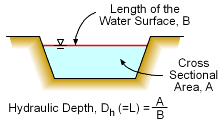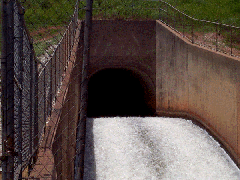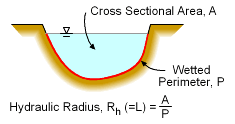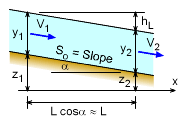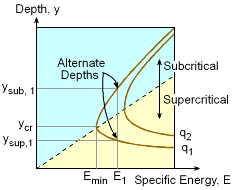| Ch 10. Open-Channel Flow | Multimedia Engineering Fluids | ||||||
|
Uniform Flow |
Gradually Varied Flow |
Rapidly Varied Flow |
|||||
| Uniform Flow | Case Intro | Theory | Case Solution | Example |
| Chapter |
| 1. Basics |
| 2. Fluid Statics |
| 3. Kinematics |
| 4. Laws (Integral) |
| 5. Laws (Diff.) |
| 6. Modeling/Similitude |
| 7. Inviscid |
| 8. Viscous |
| 9. External Flow |
| 10. Open-Channel |
| Appendix |
| Basic Math |
| Units |
| Basic Equations |
| Water/Air Tables |
| Sections |
| Search |
| eBooks |
| Dynamics |
| Fluids |
| Math |
| Mechanics |
| Statics |
| Thermodynamics |
| Author(s): |
| Chean Chin Ngo |
| Kurt Gramoll |
| ©Kurt Gramoll |
| |
|||||||||||||||||||||||||||||||||||||||||||
| This section begins with a discussion of how open-channel flow can be classified. The Froude number, an important dimensionless parameter in open-channel flow, and the concept of specific energy will be introduced. The Chezy and Manning equations are then presented for uniform flow. | |||||||||||||||||||||||||||||||||||||||||||
|
|||||||||||||||||||||||||||||||||||||||||||
 Natural Open-Channel Flow
|
Classification of Open-Channel Flow |
||||||||||||||||||||||||||||||||||||||||||
Open-channel flow refers to flow with a free water surface where the fluid flow is driven solely by gravity. Applications of open-channel flow can be found in both natural (e.g., creeks and rivers) and man-made structures (e.g., storm water sewer, sanitary sewer and canals). Open-channel flow can be classified as uniform and nonuniform flow according to its flow characteristics. For uniform flow, the velocity, depth, and cross sectional area are constant along the channel; whereas for nonuniform flow, they vary in the direction of the flow. The depth associated with uniform flow is called the normal depth. Nonuniform flow can be further divided into gradually varied and rapidly varied flow, and they will be introduced in the later sections. Open-channel flow can also be classified as steady and unsteady flow. The flow is steady when the velocity and flow depth at a given point do not change with time. On the other hand, the velocity and flow depth vary with time for unsteady flow. |
|||||||||||||||||||||||||||||||||||||||||||
| Froude Number |
|||||||||||||||||||||||||||||||||||||||||||
|
One of the most important dimensionless parameters in the study of open-channel flow is the Froude number. From dimensional analysis, Froude number is where V is the average velocity, L is the characteristic length associated with the channel (hydraulic depth), and g is the gravitational acceleration. Physically, the Froude number represents the ratio of inertial forces to gravitational forces. It also represents the ratio of fluid velocity to the wave celerity. Open-channel flow can also be classified according to the Froude
number in the following manner: It is also common to write Fr as V/c, where c is the wave celerity, c (speed of a wave in the fluid). This form is similar to the Mach Number in air. For subcritical flow (V < c), the waves created by any surface disturbances (e.g., throwing a stone in the water) at the downstream can travel upstream. On the other hand, for supercritical flow (V > c), all surface disturbances will be swept downstream. The wave will remain stationary for critical flow (V = c). |
||||||||||||||||||||||||||||||||||||||||||
| Reynolds Number |
|||||||||||||||||||||||||||||||||||||||||||
|
In addition to the Froude number, the Reynolds number is also important in open channel flow analysis, as one would expect. Recall, Reynolds number is where L is the hydraulic radius (not the radius of a circle). Care must be taken to find the right length term, L, for both Fr and Re since they are different. Open-channel flow can also be classified according to the Froude
number in the following manner: |
||||||||||||||||||||||||||||||||||||||||||
| Uniform Flow: Chezy and Manning Equations |
|||||||||||||||||||||||||||||||||||||||||||
|
As with most fluid flow problems, the velocity, V, and volumetric flow rate, Q, are both important quantities in open-channel flow and need to be determined. The most common method to determine both V and Q is with the Chezy and Manning equations. The Chezy equation can be developed using the energy equation (Bernoulli's equation) and the Darcy-Weisbach equation for pipe flow. If uniform flow is assumed (see diagram on the left), then the flow depth at any location is the same, y1 = y2. Also, the flow velocity will be the same, V1 = V2, due to continuity condition. This means that the potential energy change between 1 and 2 is only equal to the head loss, hL = z1 - z2 = So L The Darcy-Weisbach equation, which estimates the friction head loss for pipes, can be used for open channel flow if the pipe diameter, d, term changed to four times the hydraulic radius, Rh, or It is possible to use the Moody chart to find the friction factor, f, but it is an iterative process since the velocity is not known (but is needed with the Moody chart). A more common method is to equate hL with the slope, and solve for V, giving the Chezy equation as |
||||||||||||||||||||||||||||||||||||||||||
Table: Manning Coefficient
"Open Channel Hydraulics," McGraw-Hill, New York, 1959.) |
where C is equal to (8g/f)0.5 and So is the channel slope. Since the f values are hard to calculate for C, a second equation is then used to determine the C values for different channels surfaces, called the Manning equation, where n for various basic materials is listed at the left. The k is simply a conversion factor depending if SI or US units are used. For SI, k = 1 m0.33/s, for US, k = 1.486 ft0.33/s. The Manning and Chezy equations can be used together to give Note that the Manning coefficient n is the same for both unit systems, and it depends on the channel material and conditions. Some of the typical values of n obtained from experiments are summarized in the table for various channel bed conditions. |
||||||||||||||||||||||||||||||||||||||||||
| Specific Energy |
|||||||||||||||||||||||||||||||||||||||||||
|
The specific energy (E) is energy per unit weight measured relative to the channel bed, and it is given by the sum of the depth and velocity head (again assuming small bed slope and a kinetic energy correction factor of 1): E = y + V2/2g Hence, the specific energy is constant along the channel for uniform flow, but it varies for nonuniform flow. For a rectangular channel, the specific energy in terms of the discharge flow rate per unit width (q = Q/width) is given by where y is the depth from the bottom of the channel. The plot of the
specific energy as a function of the channel depth (y versus E) is plotted
as a specific energy diagram. For a given flow rate q and given specific energy E (for E > Emin), two different channel depths (ysub and ysup) are possible, and they are referred to as alternate depths. The top and bottom portions of the specific energy curve correspond to subcritical and supercritical flow, respectively. Note that the flow depth associated with the subcritical flow is much higher than for supercritical flow. |
||||||||||||||||||||||||||||||||||||||||||
Practice Homework and Test problems now available in the 'Eng Fluids' mobile app
Includes over 250 free problems with complete detailed solutions.
Available at the Google Play Store and Apple App Store.

